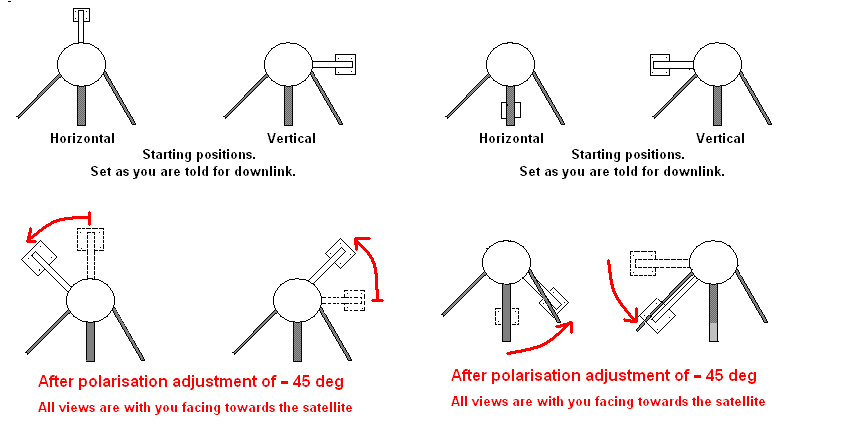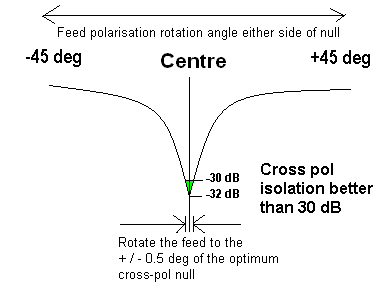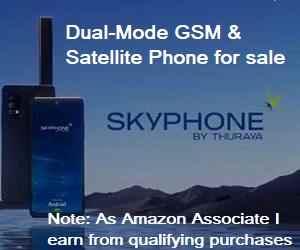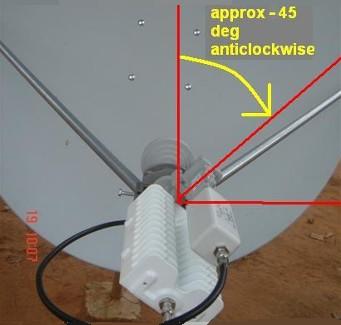1 How can I know the location of the LNB referring to Horizontal and the location referring to vertical ?, as you wrote in this article that the pin inside the LNB determine this. Is it correct ? if so which one is correct if the LNB position was on 3 o'clock , the pin should be upward or downward ? Does it make difference ?.
Ans: The pin inside the LNB defines the receive
polarisation direction.

If the pin is vertical then the polarisation is vertical. In the case of vertical polarisation, it does not matter if the pin goes up from the bottom or down from the top. The broad faces of the rectangular waveguide face in the polarisation direction.
2. where is the zero Angle ? some refer it to 12 o'clock and some to 3 o'clock.
Ans: The zero angle is your chosen starting position, vertical or horizontal. Ignore any numbers on the scales. Just use the top or side marks, typically marked 0 or 90 or -90.
3. I am using a program named SMW link, which you provide it your GPS and the sat degree and it calculate the lnb degree for you, this not fit all internet providers because as I see each one use a different angle. Also as I am trying it right now for all satellites from 22 degree west to 110 degree east the LNB angle varied from (54.5 deg) to (-54.6 deg) respectively while I see many times LNB deg out this range used by ISP.
Ans: I guess you are in the northern hemisphere. If so, a polarisation angle 54.5 for south west satellite makes sensa, as does -54.6 deg for satellites to the south east.
If you are in the northern hemisphere a satellite which is due south of you has zero polarisation adjustment angle. If the satellite is to the south east then the polarisation adjustment angle is negative, anticlockwise, facing towards the satellite. If the satellite is to the south west then the polarisation adjustment angle is positive clockwise.
If you are in the southern hemisphere. Satellite due north of you has zero polarisation adjustment angle. If it is north west then the polarisation adjustment angle is negative, anticlockwise. If it is north east then the polarisation adjustment angle is positive clockwise.
4. is the LNB position related with the sat ? , frequency ? transponder ? or what ? .
i think no and that make the case complex to me because on the the same sat and with the same service , if i use NJR LNB i should put it in a degree and when using Invacom LNB i will put it normal to that direction .
Ans: Most satellites have their planes of polarisation parallel to the earth's axis and the equator. Exceptions I know of are Eutelsat (+3.5 deg clockwise) and Astra (+7 deg clockwise). Satellites have transponders on both polarisations. That is why 1 deg accuracy is important so you don't mess up operations on the other polarisation or get interfered with from the other polarisation. Discrete VSAT LNBs with a rectangular input waveguide are single polarisation devices and you have to turn it physically to make it the opposite. (Satellite TV LNBs normally have dual polariation capability, switched internally. The very latest VSAT
Ku band TRIAs will have single polarisation transmit and single, but switchable alternative, polarisation on receive.)
5. let's assume that you will say that putting the LNB at 3 o'clock gives vertical polarisation, what is the difference between putting it on 3 o'clock or putting it on 9 o'clock?
Ans: Same. Both are alternative starting positions for vertical polarisation. Use whichever does not involve hitting metal when the adjustment angle is later applied. Sometimes the adjustment may approach + /- 90 deg if you are near the equator !
6. Patriot Dish and Visiosat dish have antenna types that come with small sub-reflector, in the case of dish with small sub-reflector how I could count the LNB degree ? .
Ans: It doesn't make any difference (to linear polarisation) there being a subreflector. Always set up the starting position to vertical or horizontal, and then apply the adjustment (clockwise+ or anticlockwise-) while facing towards the satellite.
If there is no polarisation scale or it is too small to read to 1 deg accuracy then put an inclinometer sideways across the LNB or BUC surface. Alternatively try wrapping a paper strip round the throat and marking it for one circumferance. Then unwind and measure total circumference length in mm. Adjustment required = total length x adjustment angle / 360 mm. Mark that, reapply the paper and adjust according to your paper mark.

The picture above shows all possible starting positions for horizontal and vertical, plus the effect of applying a -45 anticlockwise adjustment. Note that the view is with you behind the dish facing forwards towards the satellite.

The picture above shows how the cross-pol isolation varies as you adjust the polarisation angle. The unwanted signal is -30 dB down or 1/1000 th of the wanted one at the exact centre.
Best regards, Eric.






